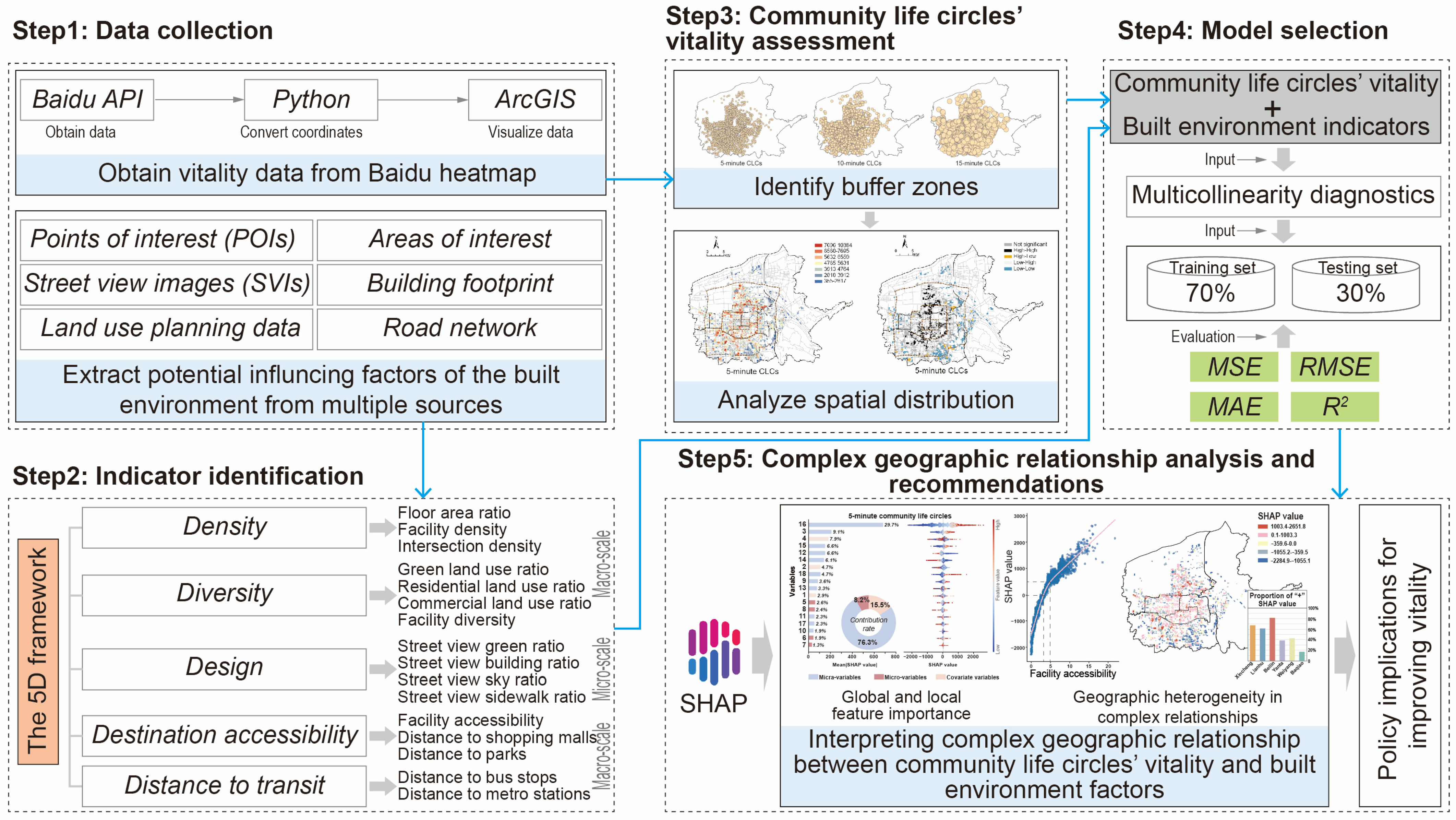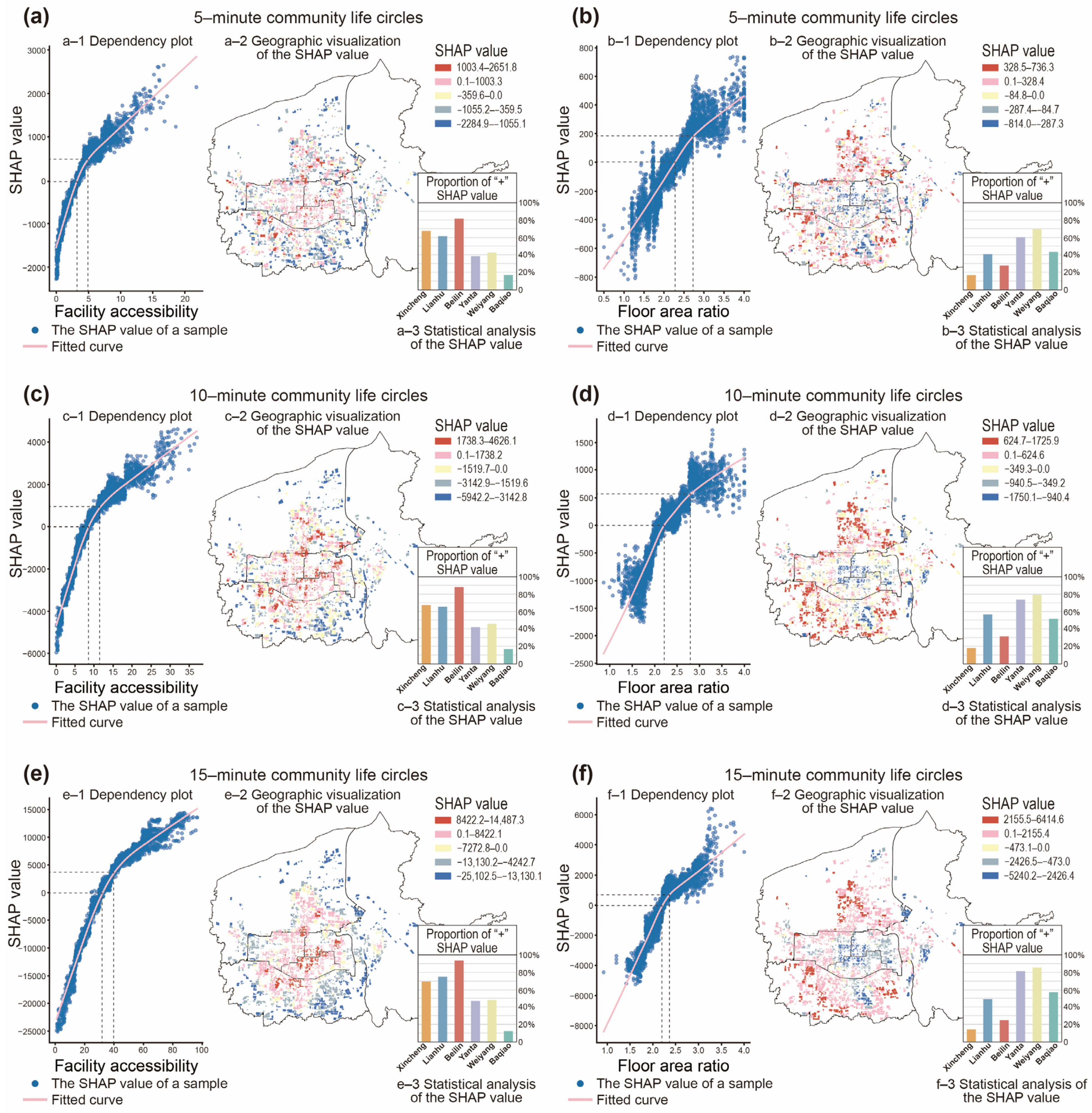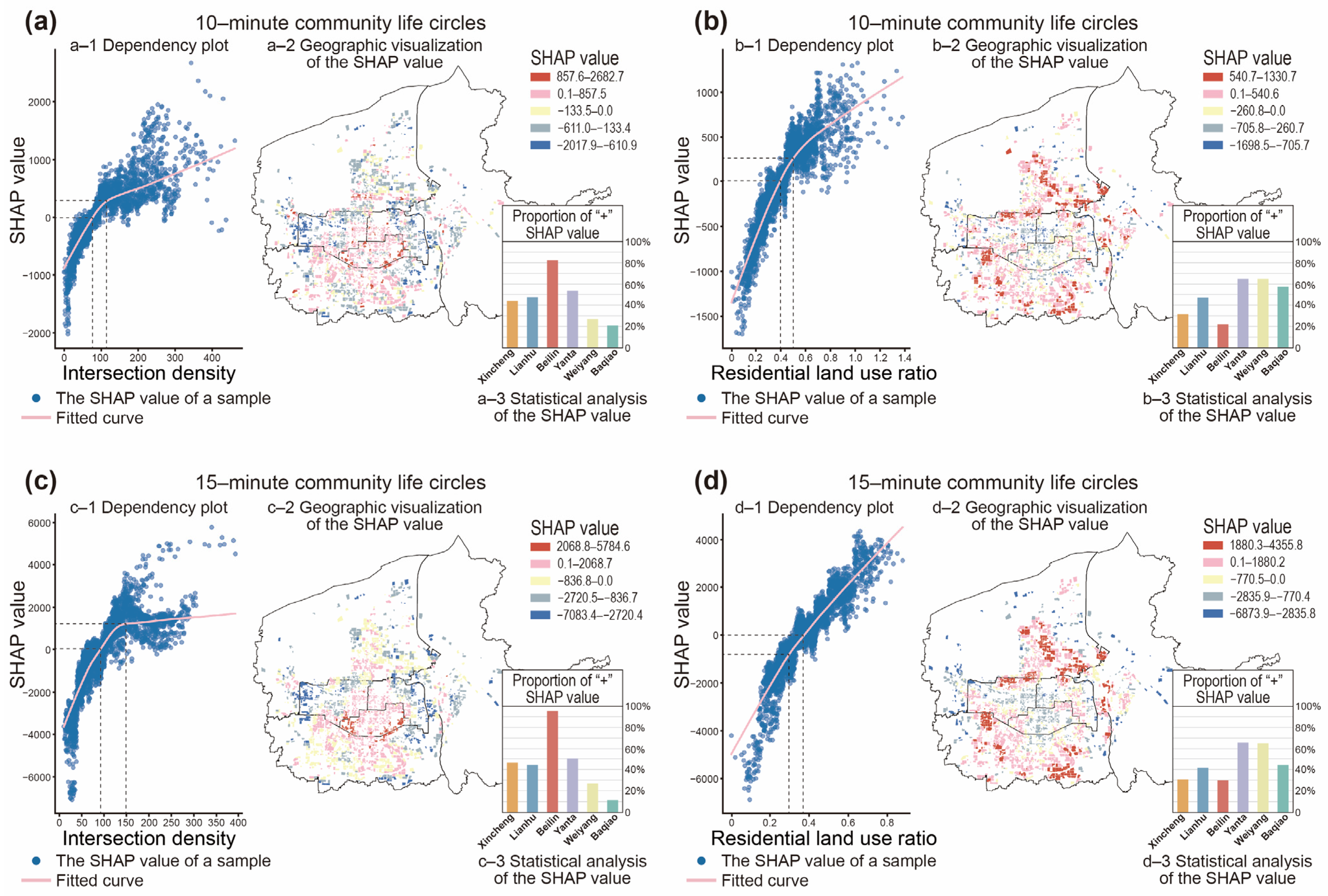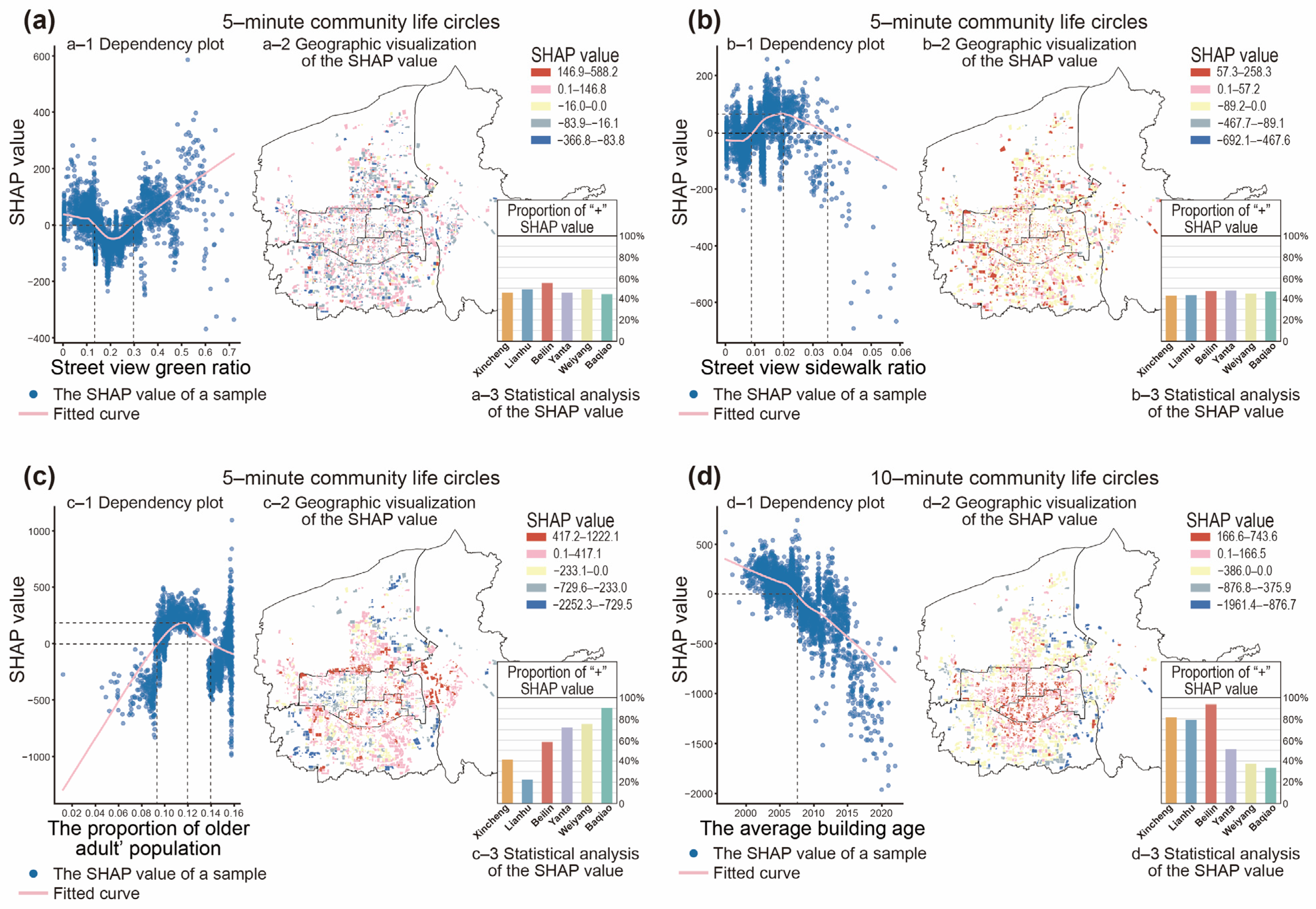Exploring the Complex Effects and Their Spatial Associations of the Built Environment on the Vitality of Community Life Circles Using an eXtreme Gradient Boosting–SHapley Additive exPlanations Approach: A Case Study of Xi’an
Abstract
:1. Introduction
1.1. The Quantification of Urban Vitality
1.2. The Impacts of the Built Environment
1.3. Research Framework
2. Methods
2.1. Study Area
2.2. Selection of Variables
2.2.1. Dependent Variable: The Vitality of Community Life Circles
2.2.2. Independent Variables: Built Environment Characteristics
2.2.3. Covariates
2.3. Spatial Autocorrelation
2.4. Machine Learning Models
2.4.1. Model Selection
- Random Forest (RF) is a decision tree algorithm based on the idea of bagging in integrated learning. RF is able to handle input samples with high-dimensional features without dimensionality reduction. Therefore, it is adaptable to the dataset.
- Gradient Boosting Decision Tree (GBDT) is a decision tree algorithm based on the idea of boosting in integrated learning. It uses the gradient boosting method of continuous iteration to gradually correct residuals, so it has advantages in dealing with regression problems.
- eXtreme Gradient Boosting (XGBoost) is an optimization machine learning algorithm proposed by Chen et al. [55] based on GBDT. XGBoost adds a regularization term, which is helpful in preventing the overfitting of the model, and performs a second-order Taylor expansion of the loss function. Therefore, the generality and applicability of this model are better.
2.4.2. Machine Learning Interpretation Tool—SHAP
3. Results
3.1. Spatial Distribution of Community Life Circles’ Vitality
3.2. Data Preprocessing and Modeling
3.3. Interpretation of Complex Relationships Based on XGBoost-SHAP
3.3.1. Contribution of Explanatory Variables to Community Life Circles’ Vitality
3.3.2. Geographic Relationships Between the Built Environment and Community Life Circles’ Vitality
4. Discussion
4.1. Complex Geographic Relationships Between Multi-Factors and Community Life Circles’ Vitality
4.2. Spatial Heterogeneity in the Effects of the Built Environment on Community Life Circles’ Vitality: The Role of Building Typologies
4.3. Policy Implications for Improving Community Life Circles’ Vitality
- (1)
- Prioritize an improvement in facility accessibility and the floor area ratio. In central urban districts (e.g., Xincheng, Lianhu, Beilin), although there is a high density of facilities, there are still problems of uneven spatial distribution, overlapping services, or mismatch between supply and demand. Therefore, areas in these districts with low community life circles’ vitality should focus on improving facility accessibility to values of 3–5 (300 m buffer zones), 9–11 (500 m buffer zones), and 32–40 (1000 m buffer zones). In peripheral urban districts (e.g., Yanta, Weiyang, Baqiao), the floor area ratio should be moderately increased (e.g., controlled within the range of 2.2–2.8) to promote compact development and improve land use efficiency, thereby improving vitality.
- (2)
- Optimize road network connectivity and the residential land use layout within a 500–1000 m buffer zone. For areas in central urban districts (e.g., Xincheng, Lianhu, Beilin) with low 10-min and 15-min community life circles’ vitality, road network connectivity can be enhanced by adding branch roads, opening disconnected roads, and increasing the intersection density to 90–120/km2. In peripheral urban districts (e.g., Yanta, Weiyang, Baqiao), the residential land use ratio should be in accordance with the requirements of the “Urban Residential Area Planning Standards” and the clustering effect of land use should be capitalized to enhance community life circles’ vitality.
- (3)
- Enhance the quality of the micro-environment within a 300 m buffer zone to improve the walking experience. In addition to macro-environmental improvements, targeted interventions in areas with low 5-min community life circles’ vitality should focus on increasing the streetscape greenery ratio to at least 30% and upgrading the sidewalk design through renewal projects. These measures can create a pedestrian-friendly environment, encouraging residents to engage in walking activities and enhancing the overall community life circles’ vitality.
- (4)
- Implement age-friendly renovation and improve the convenience of living based on regional characteristics. For areas located in peripheral urban districts (e.g., Yanta, Weiyang, Baqiao), where the proportion of the older adult population in 5-min community life circles reaches 12%, it is crucial to complete age-friendly renovations within a 300 m buffer zone as soon as possible. The potential contribution of older adults to community life circles’ vitality should be fully tapped by creating public spaces suitable for their participation, especially in 5-min community life circles. At the same time, for areas with low vitality in 15-min community life circles, priority should be given to the establishment of “15 min 15-min convenient life circles”. This action is an important urban renewal policy that Xi’an has implemented in recent years. It aims to improve the convenience of residents living within a 15-min walking distance.
5. Conclusions
Author Contributions
Funding
Data Availability Statement
Conflicts of Interest
Appendix A
| Study Area and Scale | Dataset Types | Measurement of Vitality | Methods |
|---|---|---|---|
| Wuhan, 1025 community blocks [5] | The street view images from Baidu Map | Six categories of street elements; the values were summed to denote urban vitality after normalization | Spatial lag multivariate regression model (SLM) |
| Xi’an, 1251 natural blocks [6] | Baidu heatmap data | A population heat index selected for weekdays and weekends; the average was introduced to represent vitality | Multiple linear regression model (MLR) |
| Nanjing, 27,201 units (500 m × 500 m) [12] | Baidu heatmap data and social media data from Sina Weibo | The weighted calculation results of two kinds of data were used to characterize vitality | Spatial machine learning model (SML) |
| Wuhan, 1057 communities [15] | Baidu heatmap data | The average value of the population heat index | Multi-scale geographically weighted regression (MGWR) |
| Shenzhen, 491 traffic analysis zones [17] | The POI dataset from Amap, social media check-ins from Sina Weibo, and Mobile phone positioning records | The average value of three kinds of data to represent vitality | Geographically weighted regression (GWR) |
| Nanjing, 8209 traffic analysis zones [19] | Mobile phone data and the nighttime light data | The average value of two kinds of data to represent vitality | Geographic neural network weighted regression (GNNWR) |
| Shenzhen, street blocks [20] | The POI dataset from Amap | The distribution of POI was defined as vitality | Negative binomial regression |
| Five Chinese megacities, street blocks [21] | Business check-in records from Dianping and nighttime light data from the VIIRS DNB | Urban daytime and nighttime vitality were measured using small catering business and nighttime light data, respectively | Local Moran’s I statistics |
| Variable | Community Life Circles | Variable | Community Life Circles | |||
|---|---|---|---|---|---|---|
| 5-min | 10-min | 15-min | 5-min | 10-min | ||
| Facility accessibility | 0.171464 | 0.027062 | 0.390711 | Street view green ratio | 0.000986 | |
| Floor area ratio | 0.241564 | 0.361924 | 0.445573 | Street view sidewalk ratio | 0.002875 | |
| Intersection density | 0.199716 | 0.363063 | Proportion of the older adult population | 0.100209 | ||
| Residential land use ratio | 0.154659 | 0.165901 | Building age | 0.225967 | ||
References
- Johnson, M.T.J.; Munshi-South, J. Evolution of life in urban environments. Science 2017, 358, eaam8327. [Google Scholar] [CrossRef] [PubMed]
- Liu, D.; Zhou, R.; Ma, Q.; He, T.; Fang, X.; Xiao, L.; Hu, Y.; Li, J.; Shao, L.; Gao, J. Spatio-temporal patterns and population exposure risks of urban heat island in megacity Shanghai, China. Sustain. Cities Soc. 2024, 108, 105500. [Google Scholar] [CrossRef]
- Xu, R.; Yue, W.; Wei, F.; Yang, G.; He, T.; Pan, K. Density pattern of functional facilities and its responses to urban development, especially in polycentric cities. Sustain. Cities Soc. 2022, 76, 103526. [Google Scholar] [CrossRef]
- Bille, R.A.; Jensen, K.E.; Buitenwerf, R. Global patterns in urban green space are strongly linked to human development and population density. Urban For. Urban Green. 2023, 86, 127980. [Google Scholar] [CrossRef]
- Li, X.; Li, Y.; Jia, T.; Zhou, L.; Hijazi, I.H. The six dimensions of built environment on urban vitality: Fusion evidence from multi-source data. Cities 2022, 121, 103482. [Google Scholar] [CrossRef]
- Li, J.; Chen, Y.; Zhao, D.; Zhai, J. The Impact of Built Environment on Mixed Land Use: Evidence from Xi’an. Land 2024, 13, 2214. [Google Scholar] [CrossRef]
- He, C.; Chen, T.; Mao, X.; Zhou, Y. Economic transition, urbanization and population redistribution in China. Habitat Int. 2016, 51, 39–47. [Google Scholar] [CrossRef]
- Jacobs, J.M. The Death and Life of Great American Cities; Vintage: London, UK, 1962. [Google Scholar]
- Montgomery, J. Making a city: Urbanity, vitality and urban design. J. Urban Des. 1998, 3, 93–116. [Google Scholar] [CrossRef]
- Lynch, K.M. A Theory of Good City Form; MIT Press: Cambridge, MA, USA, 1981. [Google Scholar]
- Qing-ming, W. Evaluation of Urban Vitality Based on Fuzzy Matter-Element Model. Geogr. Geo-Inf. Sci. 2010, 26, 73–77. [Google Scholar]
- Wang, Z.; Wang, X.; Liu, Y.; Zhu, L. Identification of 71 factors influencing urban vitality and examination of their spatial dependence: A comprehensive validation applying multiple machine-learning models. Sustain. Cities Soc. 2024, 108, 105491. [Google Scholar] [CrossRef]
- Alexander, C.; Silverstein, M.; Ishikawa, S. A Pattern Language; Oxford University Press: Oxford, UK, 1977. [Google Scholar]
- Salingaros, N.A.; Mehaffy, M.W. Design for a Living Planet: Settlement, Science, and the Human Future; Sustasis Foundation: Cook, WA, USA, 2015. [Google Scholar]
- Moreno, C.; Allam, Z.; Chabaud, D.; Gall, C.; Pratlong, F. Introducing the “15-Minute City”: Sustainability, Resilience and Place Identity in Future Post-Pandemic Cities. Smart Cities 2021, 4, 93–111. [Google Scholar] [CrossRef]
- Ewing, R.; Handy, S.; Brownson, R.C.; Clemente, O.; Winston, E. Identifying and Measuring Urban Design Qualities Related to Walkability. J. Phys. Act. Health 2006, 3, S223–S240. [Google Scholar] [CrossRef]
- Zeng, P.; Wei, M.; Liu, X. Investigating the Spatiotemporal Dynamics of Urban Vitality Using Bicycle-Sharing Data. Sustainability 2020, 12, 1714. [Google Scholar] [CrossRef]
- He, S.; Zhang, Z.; Yu, S.; Xia, C.; Tung, C.-L. Investigating the effects of urban morphology on vitality of community life circles using machine learning and geospatial approaches. Appl. Geogr. 2024, 167, 103287. [Google Scholar] [CrossRef]
- Sulis, P.; Manley, E.; Zhong, C.; Batty, M. Using mobility data as proxy for measuring urban vitality. J. Spatial Inf. Sci. 2018, 16, 137–162. [Google Scholar] [CrossRef]
- Tu, W.; Zhu, T.; Xia, J.; Zhou, Y.; Lai, Y.; Jiang, J.; Li, Q. Portraying the spatial dynamics of urban vibrancy using multisource urban big data. Comput. Environ. Urban Syst. 2020, 80, 101428. [Google Scholar] [CrossRef]
- Jin, X.; Long, Y.; Sun, W.; Lu, Y.; Yang, X.; Tang, J. Evaluating cities’ vitality and identifying ghost cities in China with emerging geographical data. Cities 2017, 63, 98–109. [Google Scholar] [CrossRef]
- Yang, Y.; Wang, H.; Qin, S.; Li, X.; Zhu, Y.; Wang, Y. Analysis of Urban Vitality in Nanjing Based on a Plot Boundary-Based Neural Network Weighted Regression Model. ISPRS Int. J. Geo-Inf. 2022, 11, 624. [Google Scholar] [CrossRef]
- Ye, Y.; Li, D.; Liu, X. How block density and typology affect urban vitality: An exploratory analysis in Shenzhen, China. Urban Geogr. 2018, 39, 631–652. [Google Scholar] [CrossRef]
- Xia, C.; Yeh, A.G.-O.; Zhang, A. Analyzing spatial relationships between urban land use intensity and urban vitality at street block level: A case study of five Chinese megacities. Landsc. Urban Plan. 2020, 193, 103669. [Google Scholar] [CrossRef]
- Mouratidis, K.; Poortinga, W. Built environment, urban vitality and social cohesion: Do vibrant neighborhoods foster strong communities? Landsc. Urban Plan. 2020, 204, 103951. [Google Scholar] [CrossRef]
- Wang, J.; Kwan, M.-P.; Xiu, G.; Deng, F. A robust method for evaluating the potentials of 15-minute cities: Implications for sustainable urban futures. Geogr. Sustain. 2024, 5, 597–606. [Google Scholar] [CrossRef]
- GB50180-2018; Urban Residential Area Planning Standards. Ministry of Housing and Urban-Rural Development of the People’s Republic of China: Beijing, China, 2018.
- Handy, S.L.; Boarnet, M.G.; Ewing, R.; Killingsworth, R.E. How the built environment affects physical activity: Views from urban planning. Am. J. Prev. Med. 2002, 23, 64–73. [Google Scholar] [CrossRef]
- Ewing, R.; Cervero, R. Travel and the Built Environment. J. Am. Plan. Assoc. 2010, 76, 265–294. [Google Scholar] [CrossRef]
- Chen, Y.; Yu, B.; Shu, B.; Yang, L.; Wang, R. Exploring the spatiotemporal patterns and correlates of urban vitality: Temporal and spatial heterogeneity. Sustain. Cities Soc. 2023, 91, 104440. [Google Scholar] [CrossRef]
- Yue, Y.; Zhuang, Y.; Yeh, A.G.O.; Xie, J.-Y.; Ma, C.-L.; Li, Q.-Q. Measurements of POI-based mixed use and their relationships with neighbourhood vibrancy. Int. J. Geogr. Inf. Sci. 2017, 31, 658–675. [Google Scholar] [CrossRef]
- Zhang, A.; Li, W.; Wu, J.; Lin, J.; Chu, J.; Xia, C. How can the urban landscape affect urban vitality at the street block level? A case study of 15 metropolises in China. Environ. Plan. B Urban Anal. City Sci. 2021, 48, 1245–1262. [Google Scholar] [CrossRef]
- Linwei, H.; Longyu, S.; Fengmei, Y.; Xue-qin, X.; Lijie, G. Method for the evaluation of residents’ perceptions of their community based on landsenses ecology. J. Clean. Prod. 2021, 281, 124048. [Google Scholar] [CrossRef]
- Zhu, D.; Song, D.; Zhu, B.; Zhao, J.; Li, Y.; Zhang, C.; Zhu, D.; Yu, C.; Han, T. Understanding complex interactions between neighborhood environment and personal perception in affecting walking behavior of older adults: A random forest approach combined with human-machine adversarial framework. Cities 2024, 146, 104737. [Google Scholar] [CrossRef]
- He, N.; Li, G. Urban neighbourhood environment assessment based on street view image processing: A review of research trends. Environ. Chall. 2021, 4, 100090. [Google Scholar] [CrossRef]
- Wang, H.; Yang, Y. Neighbourhood walkability: A review and bibliometric analysis. Cities 2019, 93, 43–61. [Google Scholar] [CrossRef]
- Yang, L.; Ao, Y.; Ke, J.; Lu, Y.; Liang, Y. To walk or not to walk? Examining non-linear effects of streetscape greenery on walking propensity of older adults. J. Transp. Geogr. 2021, 94, 103099. [Google Scholar] [CrossRef]
- Wang, M.; Chen, Z.; Rong, H.H.; Mu, L.; Zhu, P.; Shi, Z. Ridesharing accessibility from the human eye: Spatial modeling of built environment with street-level images. Comput. Environ. Urban Syst. 2022, 97, 101858. [Google Scholar] [CrossRef]
- Chen, L.; Jiang, X.; Tan, L.; Chen, C.; Yang, S.; You, W. Analysis of Spatial Vitality Characteristics and Influencing Factors of Old Neighborhoods: A Case Study of Ya’an Xicheng Neighborhood. Buildings 2024, 14, 3348. [Google Scholar] [CrossRef]
- Yang, J.; Cao, J.; Zhou, Y. Elaborating non-linear associations and synergies of subway access and land uses with urban vitality in Shenzhen. Transp. Res. Part A Policy Pract. 2021, 144, 74–88. [Google Scholar] [CrossRef]
- Lin, J.; Zhuang, Y.; Zhao, Y.; Li, H.; He, X.; Lu, S. Measuring the Non-Linear Relationship between Three-Dimensional Built Environment and Urban Vitality Based on a Random Forest Model. Int. J. Environ. Res. Public Health 2023, 20, 734. [Google Scholar] [CrossRef]
- Xiao, L.; Lo, S.; Liu, J.; Zhou, J.; Li, Q. Nonlinear and synergistic effects of TOD on urban vibrancy: Applying local explanations for gradient boosting decision tree. Sustain. Cities Soc. 2021, 72, 103063. [Google Scholar] [CrossRef]
- Ge, Y.; Gan, Q.; Ma, Y.; Guo, Y.; Chen, S.; Wang, Y. Spatial Vitality Detection and Evaluation in Zhengzhou’s Main Urban Area. Buildings 2024, 14, 3648. [Google Scholar] [CrossRef]
- Liu, T.; Chai, Y. Daily life circle reconstruction: A scheme for sustainable development in urban China. Habitat Int. 2015, 50, 250–260. [Google Scholar] [CrossRef]
- Rui, J.; Li, X. Decoding vibrant neighborhoods: Disparities between formal neighborhoods and urban villages in eye-level perceptions and physical environment. Sustain. Cities Soc. 2024, 101, 105122. [Google Scholar] [CrossRef]
- Zeng, Z.; Li, Y.; Tang, H. Multidimensional Spatial Driving Factors of Urban Vitality Evolution at the Subdistrict Scale of Changsha City, China, Based on the Time Series of Human Activities. Buildings 2023, 13, 2448. [Google Scholar] [CrossRef]
- Su, R.; Goulias, K. Untangling the relationships among residential environment, destination choice, and daily walk accessibility. J. Transp. Geogr. 2023, 109, 103595. [Google Scholar] [CrossRef]
- Yang, Y.; Peng, C.; Yeung, C.Y.; Ren, C.; Luo, H.; Lu, Y.; Yip, P.S.F.; Webster, C. Moderation effect of visible urban greenery on the association between neighbourhood deprivation and subjective well-being: Evidence from Hong Kong. Landsc. Urban Plan. 2023, 231, 104660. [Google Scholar] [CrossRef]
- Wu, W.; Tan, W.; Wang, R.; Chen, W.Y. From quantity to quality: Effects of urban greenness on life satisfaction and social inequality. Landsc. Urban Plan. 2023, 238, 104843. [Google Scholar] [CrossRef]
- Yu, L.; Cai, Y. Do rising housing prices restrict urban innovation vitality? Evidence from 288 cities in China. Econ. Anal. Policy 2021, 72, 276–288. [Google Scholar] [CrossRef]
- Jin, A.; Ge, Y.; Zhang, S. Spatial Characteristics of Multidimensional Urban Vitality and Its Impact Mechanisms by the Built Environment. Land 2024, 13, 991. [Google Scholar] [CrossRef]
- Fan, Z.; Duan, J.; Luo, M.; Zhan, H.; Liu, M.; Peng, W. How Did Built Environment Affect Urban Vitality in Urban Waterfronts? A Case Study in Nanjing Reach of Yangtze River. ISPRS Int. J. Geo-Inf. 2021, 10, 611. [Google Scholar] [CrossRef]
- Wu, C.; Zhao, M.; Ye, Y. Measuring urban nighttime vitality and its relationship with urban spatial structure: A data-driven approach. Environ. Plan. B Urban Anal. City Sci. 2022, 50, 130–145. [Google Scholar] [CrossRef]
- Poruthiyil, P.V.; Purandare, U. Reorienting vitality for ageing cities. Cities 2023, 137, 104268. [Google Scholar] [CrossRef]
- Chen, T.; Guestrin, C. XGBoost: A Scalable Tree Boosting System. In Proceedings of the 22nd ACM SIGKDD International Conference on Knowledge Discovery and Data Mining 2016, San Francisco, CA, USA, 13–17 August 2016. [Google Scholar]
- Liu, K.; Liao, C. Examining the importance of neighborhood natural, and built environment factors in predicting older adults’ mental well-being: An XGBoost-SHAP approach. Environ. Res. 2024, 262, 119929. [Google Scholar] [CrossRef]
- Ding, Z.; Wang, H. What are the key and catalytic external factors affecting the vitality of urban blue-green space? a case study of Nanjing Main Districts, China. Ecol. Indic. 2024, 158, 111478. [Google Scholar] [CrossRef]
- Jiang, Y.; Zhang, Y.; Liu, Y.; Huang, Z. A Review of Urban Vitality Research in the Chinese World. Trans. Urban Data Sci. Technol. 2023, 2, 81–99. [Google Scholar] [CrossRef]
- GB/T51328-2018; Urban Comprehensive Transport System Planning Standards. Ministry of Housing and Urban-Rural Development of the People’s Republic of China: Beijing, China, 2018.
- Wu, C.; Ye, Y.; Gao, F.; Ye, X. Using street view images to examine the association between human perceptions of locale and urban vitality in Shenzhen, China. Sustain. Cities Soc. 2023, 88, 104291. [Google Scholar] [CrossRef]
- Sung, H.; Lee, S. Residential built environment and walking activity: Empirical evidence of Jane Jacobs’ urban vitality. Transp. Res. Part D Transp. Environ. 2015, 41, 318–329. [Google Scholar] [CrossRef]
- Seong, E.Y.; Lee, N.H.; Choi, C.G. Relationship between Land Use Mix and Walking Choice in High-Density Cities: A Review of Walking in Seoul, South Korea. Sustainability 2021, 13, 810. [Google Scholar] [CrossRef]









| Variable | Formula | Description | |
|---|---|---|---|
| Density | Floor area ratio | = | Ratio of building area to the community life circle area. |
| Facility density | = | Ratio of facility/intersection number to the community life circle area. | |
| Intersection density | = | ||
| Diversity | Green land use ratio | = | Ratio of green/residential/commercial land use area to the community life circle area. |
| Residential land use ratio | = | ||
| Commercial land use ratio | = | ||
| Facility diversity | = | represents the proportion of facility categories within the community life circles. | |
| Design | Street view green ratio | = | Average pixel ratio of vegetation/building/sky/sidewalk in SVIs within the community life circles. |
| Street view buildings ratio | = | ||
| Street view sky ratio | = | ||
| Street view sidewalk ratio | = | ||
| Destination accessibility | Facility accessibility | = | represents the opportunities in the community life circles; equals 1 if the distance is within the predetermined range and 0 otherwise. |
| Distance to shopping malls | = | Nearest distance to shopping malls/parks. | |
| Distance to parks | = | ||
| Distance to transit | Distance to bus stops | = | Nearest distance to bus stops/metro stations. |
| Distance to metro stations | = |
| Main Categories | Subcategories | Main Categories | Subcategories | Main Categories | Subcategories |
|---|---|---|---|---|---|
| Commerce | Grocery | Commerce | Bank/ATM | Recreation | Activity center |
| Convenience store | Education | Childcare center | Senior daycare center | ||
| Supermarket | Kindergarten | Multifunctional square | |||
| Restaurant | Elementary school | Gym/fitness facility | |||
| Shopping mall | Middle school | Healthcare | Healthcare center | ||
| Pharmacy | Recreation | Bookstore | Clinic | ||
| Barber | Park | Transportation | Bus stop | ||
| Laundry | Community garden | Metro station |
| Model | Community Life Circles | |||||||||||
|---|---|---|---|---|---|---|---|---|---|---|---|---|
| 5-min | 10-min | 15-min | ||||||||||
| MSE | RMSE | MAE | R2 | MSE | RMSE | MAE | R2 | MSE | RMSE | MAE | R2 | |
| RF | 0.46 | 0.68 | 0.51 | 0.47 | 0.30 | 0.55 | 0.31 | 0.72 | 0.05 | 0.22 | 0.12 | 0.88 |
| GBDT | 0.45 | 0.67 | 0.52 | 0.47 | 0.26 | 0.51 | 0.32 | 0.78 | 0.06 | 0.24 | 0.17 | 0.91 |
| XGBoost | 0.43 | 0.66 | 0.52 | 0.53 | 0.20 | 0.45 | 0.35 | 0.79 | 0.06 | 0.24 | 0.19 | 0.94 |
| Rank | Variable (Contribution Rate) | ||
|---|---|---|---|
| 5-min Community Life Circles | 10-min Community Life Circles | 15-min Community Life Circles | |
| 1 | Facility accessibility (29.7%) | Facility accessibility (30.2%) | Facility accessibility (41.2%) |
| 2 | Floor area ratio (9.1%) | Floor area ratio (9.7%) | Floor area ratio (9.1%) |
| 3 | Proportion of the older adult population (7.9%) | Intersection density (7.3%) | Intersection density (7.3%) |
| 4 | Distance to parks (6.6%) | Residential land use ratio (7.0%) | Residential land use ratio (7.1%) |
| 5 | Distance to metro stations (6.6%) | Distance to shopping malls (6.6%) | Average building age (5.6%) |
Disclaimer/Publisher’s Note: The statements, opinions and data contained in all publications are solely those of the individual author(s) and contributor(s) and not of MDPI and/or the editor(s). MDPI and/or the editor(s) disclaim responsibility for any injury to people or property resulting from any ideas, methods, instructions or products referred to in the content. |
© 2025 by the authors. Licensee MDPI, Basel, Switzerland. This article is an open access article distributed under the terms and conditions of the Creative Commons Attribution (CC BY) license (https://creativecommons.org/licenses/by/4.0/).
Share and Cite
Liu, K.; Zhou, D.; Qi, Y.; Zhang, M.; Ren, Y.; Wei, Y.; Wang, J. Exploring the Complex Effects and Their Spatial Associations of the Built Environment on the Vitality of Community Life Circles Using an eXtreme Gradient Boosting–SHapley Additive exPlanations Approach: A Case Study of Xi’an. Buildings 2025, 15, 1372. https://doi.org/10.3390/buildings15081372
Liu K, Zhou D, Qi Y, Zhang M, Ren Y, Wei Y, Wang J. Exploring the Complex Effects and Their Spatial Associations of the Built Environment on the Vitality of Community Life Circles Using an eXtreme Gradient Boosting–SHapley Additive exPlanations Approach: A Case Study of Xi’an. Buildings. 2025; 15(8):1372. https://doi.org/10.3390/buildings15081372
Chicago/Turabian StyleLiu, Keju, Dian Zhou, Yingtao Qi, Mingzhi Zhang, Yulin Ren, Yupeng Wei, and Jinghan Wang. 2025. "Exploring the Complex Effects and Their Spatial Associations of the Built Environment on the Vitality of Community Life Circles Using an eXtreme Gradient Boosting–SHapley Additive exPlanations Approach: A Case Study of Xi’an" Buildings 15, no. 8: 1372. https://doi.org/10.3390/buildings15081372
APA StyleLiu, K., Zhou, D., Qi, Y., Zhang, M., Ren, Y., Wei, Y., & Wang, J. (2025). Exploring the Complex Effects and Their Spatial Associations of the Built Environment on the Vitality of Community Life Circles Using an eXtreme Gradient Boosting–SHapley Additive exPlanations Approach: A Case Study of Xi’an. Buildings, 15(8), 1372. https://doi.org/10.3390/buildings15081372








